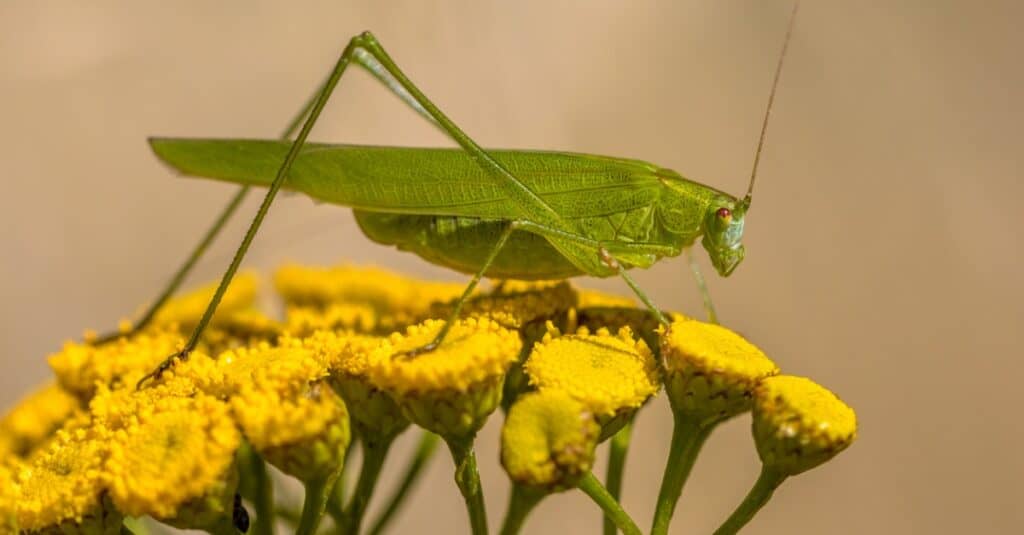Katydid
Tettigoniidae
Advertisement
Katydid Scientific Classification
- Kingdom
- Animalia
- Phylum
- Arthropoda
- Class
- Insecta
- Order
- Orthoptera
- Family
- Tettigoniidae
- Genus
- Tettigonia
- Scientific Name
- Tettigoniidae
Read our Complete Guide to Classification of Animals.
Katydid Conservation Status
Katydid Facts
- Prey
- Insects, snails, small vertebrates
- Name Of Young
- Nymphs
- Group Behavior
- Solitary
- Estimated Population Size
- billions
- Most Distinctive Feature
- Trilling songs
- Other Name(s)
- Bush cricket
- Average Spawn Size
- 20
- Habitat
- Every continent except Antarctica
- Predators
- Birds, lizards, frogs, bats, insects
- Diet
- Omnivore
- Lifestyle
- Nocturnal
- Solitary
- Favorite Food
- Leaves and fruit
- Number Of Species
- 8000
View all of the Katydid images!
Summary
Found on every continent except Antarctica, Katydids are a family of primarily nocturnal insects. They closely resemble grasshoppers and used to go by the name long-horned grasshoppers. However, in reality, they are more closely related to crickets, hence their other common name, the bush cricket. Male Katydids produce trilling songs through a process known as stridulation, which they use to attract females. While some Katydids are herbivorous, others are carnivores, and many utilize mimicry or camouflage to avoid predators.
5 Katydid Facts
- There are over 8,000 known species of Katydid, of which the common true Katydid is the dominate subspecies in North America.
- Male Katydids provide a nuptial gift to females while mating to distract them and increase their chances of paternity.
- While resting during the day, Katydids disguise themselves as leaves to avoid predators.
- Some Katydids have spines on their bodies that can help them trap and hold onto prey or ward off predators.
- For some species, you can tell what the temperature is outside by the number of chirps the males make in a set period of time.
Katydid Scientific Name
There are more than 8,000 known species of Katydid, all of which belong to the family Tettigoniidae. The word Tettigonia comes from the Greek word tettigonion, which means cicada. Tettigonion is itself the diminutive of the onomatopoeic word tettix, which imitates the sounds Katydids create by rubbing parts of their body together. Similarly, the common name Katydid is also onomatopoeic, as it imitates the three-part song commonly sung by these insects, hence ka-ty-did. In North America, the word Katydid is normally used to refer to the common true Katydid, or Pterophylla camellifolia.
Katydid Appearance
Katydids vary greatly in size depending on the species. That said, most range between 0.2 inches to 5.1 inches long. The majority of Katydids measure on the larger size of the spectrum, and smaller species tend to live in drier, more arid regions. While most Katydids appear bright green or mimic the appearance of leaves, they come in a variety of colors, ranging from pink to yellow.
One of the most distinctive features of Katydids is their wings. Their wings can feature distinctive markings or patterns and can measure large enough to cover nearly the entire body. Some species sport a wingspan that measures nearly 10 inches long. Meanwhile, others have short wings that render them practically flightless. In addition to long wings, Katydids also feature relatively long, thin antennae, unlike grasshoppers, whose antennae normally appear short and thick, thereby allowing you to more easily differentiate the two.

Katydids hunt aphids and some tropical species use spikes on their legs to catch insects.
©iStock.com/CreativeNature_nl
Katydid Behavior
Generally speaking, Katydids are solitary insects that only congregate when it’s time to mate. During the mating season, males must often compete with one another for the attention of females. That said, they are docile by nature and a relatively gentle species that pose no danger to humans. Although Katydids can bite, their bites are not medically significant. At worst, a Katydid’s bite may cause very mild pain and is comparable to the bite of a small ant.
For the most part, Katydids do everything they can to avoid drawing the attention of predators. This is why most Katydids employ camouflage to help them blend in with their surroundings. On the other hand, some Katydids take an entirely different approach to avoid being eaten. For example, some species have bright color patterns to warn predators of their noxious chemical secretions, while others produce an unpleasant odor when under attack.
Katydid Habitat
You can find Katydids all over the world and on every continent except Antarctica. However, the majority of Katydids live in tropical regions, with a smaller number found in temperate regions, and a minority found in dry, desert regions. For example, the Amazon Rainforest is home to an estimated 2,000 Katydid species. Meanwhile, North America has around 255 Katydid species. Katydids commonly live in forests, woods, parks, gardens, and fields, where they have access to plenty of food and can blend in with vegetation to hide from predators.
Katydid Diet
When viewed as a group, Katydids are omnivores that eat both plant and animal matter. That being said, most species are primarily herbivorous. Katydids are primarily known for eating leaves and fruit, but they also often eat nectar, pollen, grass, and seeds. Due to their habit of eating commercial crops, Katydids are often considered pests but rarely cause significant environmental harm. Meanwhile, some katydids are carnivores that prey on other animals. They typically feed on other insects or snails which they trap using spines on their bodies. Especially large Katydids can even target small vertebrates such as snakes and lizards.
Katydid Predators and Threats
A number of different animals prey on Katydids in the wild. Their main predators include birds, lizards, spiders, frogs, bats, and small rodents. To survive, Katydids have evolved a number of tactics that help them avoid or ward off predators. First and foremost, Katydids are nocturnal, which aids them in avoiding detection. During the day, many Katydids rely on camouflage by assuming a resting pose that makes them look like leaves. On the other hand, a few Katydids take a different approach and make themselves unappetizing by adopting warning colors or emitting unpleasant odors. As an additional defense mechanism, their bodies are also covered in sharp spines that help to ward off threats.
Katydid Reproduction and Life Cycle
As is the case with many species, male Katydids compete for the attention of females. They accomplish this by using the sound-producing organs located on their front wings to create trilling songs. The males use stridulation by rubbing the file, which has tough ridges, against the plectrum, thereby producing vibration. In some species, the tempo at which Katydids sing is determined based on the ambient temperature.
Katydids are polygamous, and a single female will often mate with several males. In order to increase their chance of paternity, males provide females with a nuptial gift known as a spermatophylax. Females will pursue males that provide the largest food gifts, which can sometimes put them at risk of predation. That said, the payoff is usually worthwhile, as the best-fed females produce the most eggs.
Female Katydids lay oval-shaped eggs in living or dead plant matter. Once the infant Katydids hatch, most nymphs look like smaller, wingless versions of their adult selves. However, in some species, nymphs employ mimicry to look like other species such as ants or spiders. The infants go through several molts until they reach sexual maturity, at which point they stop molting.
Katydid Population
It’s hard to know for sure how many Katydids there are in the world, as they are relatively solitary insects and live in a wide range of habitats. For the most part, Katydid populations appear to be rather stable and do not show any significant signs of decline except for a few scattered species. Given their distribution and the number of species, it’s safe to say there are several billion or tens of billions of Katydids on Earth at any one time.
Katydid Locations
Katydids are a global species that can be found all over the world except for Antarctica. The vast majority of Katydids live in tropical locations such as the Amazon Rainforest. However, you can also find them in temperate forests, woods, parks, and gardens. Katydids tend to spend most of their time in thick vegetation such as grass, trees, or bushes, where they can easily blend in with their environment and have access to plenty of food.
Katydid Conservation Status:
By and large, Katydids are relatively numerous and widespread. As a result, the IUCN considers most Katydids to be species of Least Concern. However, there are several species that are rarer. For example, the Tree Winter Katydid and the Lesotho Meadow Katydid are both considered Endangered due to declining populations in their native habitats.
View all 77 animals that start with KKatydid FAQs (Frequently Asked Questions)
Are Katydids carnivores, herbivores, or omnivores?
Katydids are omnivores that eat plant and animal matter. Some species are primarily herbivorous, eating mostly leaves and fruits, while others are carnivorous, subsisting primarily on other insects and snails.
What does the name Katydid mean?
The name Katydid is an onomatopoeic imitation of the sounds that Katydids make. Some males elicit a distinctive, three-part trill that sounds like ka-ty-did.
What does a Katydid look like?
Generally speaking, Katydids look a lot like grasshoppers, hence their old name, long-horned grasshoppers. Like grasshoppers, they look primarily green and have long wings. However, unlike grasshoppers, which have short, thick antennae, the antennae on Katydids are long and thin.
Are Katydids beneficial or harmful?
Due to their size and lack of venom, Katydids are not harmful to humans. Although their bite can be mildly painful, it is not medically significant. That said, some Katydids do pose a threat to certain commercial crops.
Thank you for reading! Have some feedback for us? Contact the AZ Animals editorial team.

















